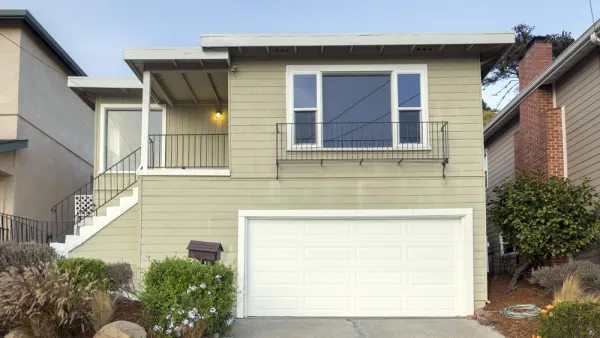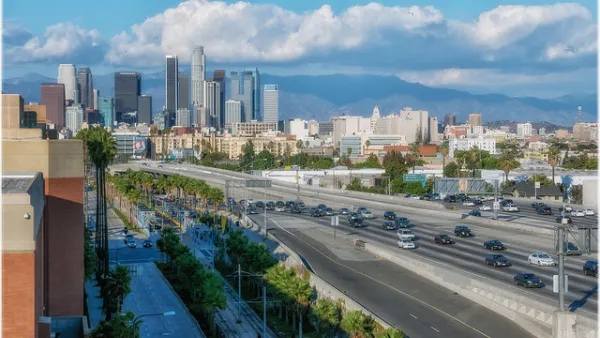A bill to reduce parking minimums for residential or mixed-use developments that include affordable units passed a key Senate committee. AB 744 amends the state's density bonus law, itself controversial, that incentivizes building affordable housing.
AB 744, authored by Assemblymember Ed Chau (D-Monterey Park), Chair of the Assembly Committee on Housing and Community Development, passed the Assembly on June 4 and is now working its way through the Senate. Melanie Curry reports for Streetsblog California on the hearing in its first Senate committee, Transportation and Housing, where it passed 7-4 on July 7.
"The bill, AB 744, would reduce parking requirements for affordable housing developments, making it less expensive to build affordable housing and using federal tax credits to build housing rather than unnecessary parking," writes Curry. "Some of the senators on the transportation committee showed a deep misunderstanding of the effects of parking policies, as well as of the larger purpose of the bill."
Actually, that's somewhat understandable, as this bill only relates to what is called the density bonus which developers may not wish to claim even if eligible.
Density Bonus Law
"DBL was first enacted in 1979 to address the State's shortfall of affordable housing," writes Matthew Hinks of the California Land Use blog. "It does so by offering incentives to developers to include low income housing in new construction projects." Citing a court case, Hinks continues:
"Although application of the statute can be complicated, its aim is fairly simple: When a developer agrees to construct a certain percentage of the units in a housing development for low or very low income households, or to construct a senior citizen housing development, the city or county must grant the developer one or more itemized concessions and a 'density bonus,' which allows the developer to increase the density of the development by a certain percentage above the maximum allowable limit under local zoning law."
Back to AB 744: it amends existing density bonus law (Government Code Section 65915-65918) by targeting two specific (narrow?) types of projects:
- 100 percent affordable that are either a seniors-only development, or a development that serves special needs individuals, located within one-half mile of a major transit stop
Affordable housing developers would not need to provide parking greater than .5 spaces per unit if they meet the above criteria.
- "For mixed income developments (i.e., a mix of affordable plus market rate) units, within one-half mile of a major transit stop that include the maximum number of very low- or low income units under Density Bonus Law the parking requirement cannot exceed 0.5 per bedroom," according to the AB 744 fact sheet.
What does the "maximum" refer to? Scroll down the text of the bill to the chart showing "Percentage Low-Income Units" and corresponding "Percentage Density Bonus."
Controversy over the density bonus law can be seen in a trio of 2008-9 posts about the use of the law in Los Angeles (in "Related" below) that culminated with a judge rejecting parts of a city ordinance based on the state law (SB 1818) at that time.
In a five-part series, Urban One, "a boutique Los Angeles based firm that specializes in the management of complex urban development projects for public and private clients," Shane Phillips "outlines recommendations and proposals for improving the California/Los Angeles density bonus program."
Part 1 focuses on background, while Parts 2 through 5 include specific recommendations to improve the density bonus and affordable housing provision throughout the region.
As the Los Angeles controversy shows, the state law needs to be incorporated into city ordinance to be implemented. A recent northern California illustration for a mixed-used development is reported by Gennady Sheyner in Palo Alto online. The current density bonus law is based on AB 2222, signed into law on September 27, 2014.
"Now it goes to the Committee on Governance and Finance, where it will be heard as soon as next week," writes Curry.
Hat tip to John Holtzclaw.
FULL STORY: Bill to Reform Parking Minimums Passes CA Senate Transportation Committee

Analysis: Cybertruck Fatality Rate Far Exceeds That of Ford Pinto
The Tesla Cybertruck was recalled seven times last year.

National Parks Layoffs Will Cause Communities to Lose Billions
Thousands of essential park workers were laid off this week, just before the busy spring break season.

Retro-silient?: America’s First “Eco-burb,” The Woodlands Turns 50
A master-planned community north of Houston offers lessons on green infrastructure and resilient design, but falls short of its founder’s lofty affordability and walkability goals.

Test News Post 1
This is a summary

Analysis: Cybertruck Fatality Rate Far Exceeds That of Ford Pinto
The Tesla Cybertruck was recalled seven times last year.

Test News Headline 46
Test for the image on the front page.
Urban Design for Planners 1: Software Tools
This six-course series explores essential urban design concepts using open source software and equips planners with the tools they need to participate fully in the urban design process.
Planning for Universal Design
Learn the tools for implementing Universal Design in planning regulations.
EMC Planning Group, Inc.
Planetizen
Planetizen
Mpact (formerly Rail~Volution)
Great Falls Development Authority, Inc.
HUDs Office of Policy Development and Research
NYU Wagner Graduate School of Public Service




























